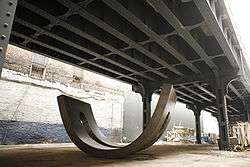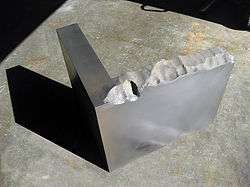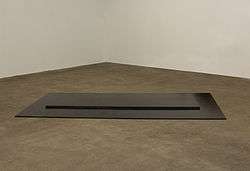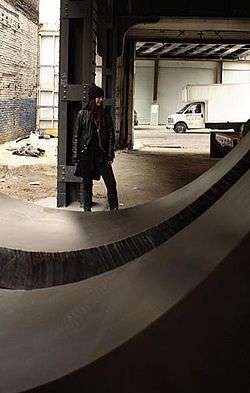Christine Corday
Christine Corday (born in 1970, Laurel, Maryland) is an American painter and sculptor. Her work draws from earlier studies in astronomy, cultural anthropology, chemistry, and sensory perception science.[1] Corday's artistic approach consist of manipulation of matter into different states, producing massive sculptures that viewers are meant to experience through touch, leaving memories on the surface of her work.[2] Her works are found in private international collections: Paris, Madrid, Dublin, Tokyo, Los Angeles, San Miguel de Allende, Dubai, Brussels, Washington DC, and New York City. With Corday's first solo exhibition: PROTOIST SERIES: SELECTED FORMS, presented at the Los Angeles County Museum of Art.[3]
Early Life and Education
A Maryland native, Corday's interest in the arts and science was marked by her classical training in piano during her formative years. In 1991, before receiving her B.A. in Communication Arts (1992), she wrote an original research paper which led to an Astrophysics internship at NASA Ames Research Center.[4] Corday continued her academic studies later on in graduate courses in Cultural Anthropology at Washington University. From 1992-1999, she worked in graphic and structural design for advertising companies, such as Wieden+Kennedy, Bartle Bogle Hegarty, and SKUzzio Design.[5] In 1999 and 2000, Corday began devoting her time to painting. She spent one year in Tokyo, Japan, then would later go to Seville, Spain for three years working on her sound and tidal energy project called Instrument for the Ocean to Play.[6] Corday's work and experiences in Spain shifted her palette to black, hand-making her own tar-like paint through raw pigments, charcoal, and synthetic polymers, and fabricated tools to apply the paint to raw linen and canvas. Corday's black palette painting are considered to be early blueprints of her sculptural work.[3]
Career
In 1992-1999, Corday worked internationally for advertising and design agencies as a graphic and structural designer.
PROTOIST Series



Corday's first steel work entitled UNE is a three-ton form beginning the artist's PROTOIST SERIES. "PROTOIST" is a term coined by the artist to describe the intermediary state between the known and the unknown. UNE is hewn from 3 tons of raw weathering steel, standing nearly 9 feet tall with a 13 inch thick arc spanning more than 16 feet. A 2.5 foot torch-cut void runs through the center of the arc; its resulting passage replaces the artist’s hand, or the stroke, in an otherwise mechanical process. UNE began its international tour with a debut exhibition in Chelsea under the High Line (New York City), (November 7– December 12, 2008; Curator: Beverly Allan), the Form "inspired local construction workers to make a three-inch steel effigy, which they gave to the artist as a present; what it will evoke elsewhere is anyone's guess."[7]
The PROTOIST SERIES is conceived and constructed to be consumed by the hand, not only to be touched but to be worn down over time by the tide of human interaction. "Each piece in the PROTOIST SERIES is meant to be touched, to be entered, and even to be walked upon."[8] The Forms are intervened for a sole evening or limited duration in locations—an abandoned interior, an urban alley, a marble piazza—that are selected to motivate the unexpected encounter.
AHN,[9] Corday's second work in the PROTOIST SERIES was installed in the corner of a 5,000 sq. ft. art space in Greenpoint, Brooklyn: Allan Nederpelt.[10] The 300 pound carbon steel piece supports the juxtaposition of three visible dimensional planes, reminding it’s experiencer of the intersecting choices constructing reality and the impermanence/permanence of time and place. Art reviewer Enrico Gomez spoke to AHN's "grounding resonance" saying, "It optically strums like an electric bass and has considerable gravitational pull."[11]
In 2011, the 60" x 120" (151 cm x 303 cm) maquette of PROTOIST Form ÆPI[12] was previewed during the exhibition, All That Is Unseen, curated by Meg O'Rourke and Caris Reid in New York City. The title of the Form fuses the meaning and pronunciation of the Greek root "epi" (upon) from the English words epicenter and epoch with the lost sound of Latin diphthong Æ. The Form’s torch-cut center plate is an abstraction of the figurative self as plateau or stair––standing on its plane shifts a single dimension of perception by 1 and 1/2 inches[13] thus acutely honing the senses to their most subtle realms––a quiet big bang, a floating grounded void, an intimate invitation to the unseen.
Corday has work in private collections in Dubai, Dublin, Mexico City, Madrid, Brussels, and Paris.
Corday's current works include a permanent abstract installation series entitled HELDAN as well as the production of a monumental outdoor form, INSTRUMENT FOR THE OCEAN TO PLAY, that harvests tidal power to create a low-frequency sound.

Paint
In 2000, Corday moved her studio from Tokyo, Japan to Seville, Spain. The years in Spain (2000–2004), Corday's palette was limited to black. Corday created her own paint mulling raw pigment and charcoal into a synthetic polymer base to create a tar-like substance and fabricated tools for its application to raw linen and canvas. Corday moved back to the United States in 2005 to a studio in Greenpoint, Brooklyn, New York. She created a series of painted works as abstract blueprints for the form HELDAN and the PROTOIST Series. In 2009, Corday's painted work entitled THAHLES[14] (72" x 216") was acquired by the Richard Meier collection installed at 165 Charles Street, New York City, New York. And in 2013, PROME[15] was acquired by the collection of Skidmore, Owings & Merrill’s San Francisco office, overseen by Craig W. Hartman.
September 11 Memorial
As seen in "Making the 9/11 Memorial" documentary by History (TV channel) and "Rising, Rebuilding Ground Zero" documentary series by the Discovery Channel, National September 11 Memorial architect Michael Arad selected Corday's black patina[16] for the finish of the bronze name parapets which carry the 2,983 victims names from the September 11 attacks and the 1993 World Trade Center bombing. The bronze name parapets border the edge of the North and South waterfall pools that occupy the former footprints of the North and South Towers.[17]
The selection process for the finish of the bronze was directed by KC Fabrications, an art and architectural fabrication company in Gardiner, New York. KC Fabrications awarded the Bronze Name Parapets through their unique engineering idea in the fabrication and installation of the Memorial.[18] “Every name has run under the palm of my hand,” Corday said. “Each name here is a life, and that’s never been lost on anyone that’s worked on this project.”[19]
Awards and Prizes
Corday received the Edison Ingenuity Prize in Montreal, Canada and has also won a number of international design awards for her patented glass bottle for the Republic of Tea.[20] In 2000, Corday was selected for a Short Story prize from Francis Ford Coppola's fiction magazine Zoetrope.[6]
Personal life
Between 1996 and 2005, she lived and worked in Portland, Oregon; San Francisco, and Los Angeles, California; Tokyo, Japan; and Seville, Spain. During this time, Corday's work evolved solely in the fine arts, specifically into form such as sculpture and architecture.
Corday lives in New York.[4]
References
- ↑ "Christine Corday: Protoist Series, Selected Forms". LACMA. Museum Associates 2011. Retrieved 7 May 2015.
- ↑ "Christine Corday: Protoist Series: Selected Forms". LACMA. Retrieved 9 May 2015.
- 1 2 "Corday Bio". Christine Corday. Retrieved 9 May 2015.
- 1 2 "christine_corday_artist". Corday.org. Retrieved 2014-04-19.
- ↑ "Corday Bio". Christine Cordday. Retrieved 7 May 2015.
- 1 2 "Corday Bio". Christine Corday. Retrieved 8 May 2015.
- ↑ David Coggins (December 11, 2008), Leaving on a flatbed truck: UNE, Interview Magazine, retrieved 2008-12-11
- ↑ Friends of the Highline (November 14, 2008), Corday's UNE Sculpture Now On View Under the High Line, Friends of the Highline, retrieved 2008-11-14
- ↑ "christine_corday_ahn_iv". Christinecorday.com. Retrieved 2014-04-19.
- ↑ Archived September 9, 2010, at the Wayback Machine.
- ↑ Enrico Gomez (October 6, 2010), FIT, WagMag Brooklyn Art Guide, retrieved 2010-10-06
- ↑ "christine_corday_aepi_i". Christinecorday.com. Retrieved 2014-04-19.
- ↑ Daniel Kunitz (February 16, 2011), The Agenda, ARTINFO, retrieved 2011-02-16
- ↑ "paintthahles". Corday.org. Retrieved 2014-04-19.
- ↑ "christine_corday_paint_prome". Christinecorday.com. Retrieved 2014-04-19.
- ↑ Zinkat, Kenneth N. (2011-09-10). "The world observes the 10-year anniversary of Sept. 11 - Framework - Photos and Video - Visual Storytelling from the Los Angeles Times". Framework.latimes.com. Retrieved 2014-04-19.
- ↑
- ↑ Mike Townshend (March 15, 2011), A tribute, Hudson Valley Times, retrieved 2011-03-15
- ↑ Robert D. McFadden (September 11, 2011), 10 Years After Sept. 11: A Day That Stands Alone, The New York Times, retrieved 2011-09-11
- ↑ "Corday Bio". Christine Corday. Retrieved 7 May 2015.
External links
| Wikimedia Commons has media related to Christine Corday. |
- Official website
- Christine Corday: Protoist Series, Selected Forms. Los Angeles County Museum of Art
- Corday: UNE. The High Line, New York City